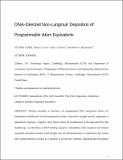DNA-Directed Non-Langmuir Deposition of Programmable Atom Equivalents
Author(s)
Lewis, Diana Jean; Gabrys, Paul Anthony; Macfarlane, Robert J
DownloadAccepted version (1.146Mb)
Publisher Policy
Publisher Policy
Article is made available in accordance with the publisher's policy and may be subject to US copyright law. Please refer to the publisher's site for terms of use.
Terms of use
Metadata
Show full item recordAbstract
Particle assembly at interfaces via programmed DNA interactions allows for independent modification of both nanoparticle-surface interaction strength and the magnitude of interparticle repulsion. Together, these factors allow for modification of the deposited thin film morphology via alterations in DNA binding sequence. Importantly, both Langmuir and random sequential adsorption models yield insights into the thermodynamics of deposition but cannot fully explain particle coverage as a function of all relevant variables, indicating that the particle deposition mechanism for DNA-grafted colloids is more complex than prior adsorption phenomena. Here, it is shown that these deviations from standard behavior arise from the fact that each nanoparticle is attached to the surface via multiple weak DNA duplex interactions, enabling diffusion of adsorbed colloids across the substrate. Thus, surface migration of individual particles causes reorganization of the deposited monolayer, leading to the unusual behavior of coverage increasing at elevated temperatures that are just below the particle desorption temperature. The programmability of DNA-directed particle deposition therefore allows for precise control over the morphology of monolayer films, as well as the ability to generate crystalline materials with controllable surface roughness and grain size through layer-by-layer growth. The increased control over thin film morphology potentially enables tailoring of mechanical and optical properties and holds promise for use in a variety of applications.
Date issued
2018-08Department
Massachusetts Institute of Technology. Department of Aeronautics and Astronautics; Massachusetts Institute of Technology. Department of Materials Science and EngineeringJournal
Langmuir
Publisher
American Chemical Society (ACS)
Citation
Lewis, Diana J., Paul A. Gabrys and Robert J. Macfarlane. “DNA-Directed Non-Langmuir Deposition of Programmable Atom Equivalents.” Langmuir, 34, 49 (August 2018): 14842–14850 © 2018 The Author(s)
Version: Author's final manuscript
ISSN
0743-7463